
A Time of Peace and Goodwill
|
Christmas, celebrated by Christians as the day of Jesus Christ's birth, and by others as a day for goodwill and peace. On this page you'll find stories, as they relate to both the religious and non-religious aspects of this holiday. Also on this page, I have provided links for Christmas activities and recipes. |
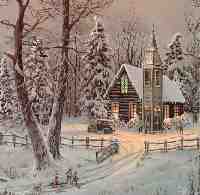 |

Christmas Fun |
Follow the links to pages with Christmas activities, songs and recipes to enjoy! |
 Christmas Activities Christmas Activities
|
 Christmas Recipes Christmas Recipes
|
Email Santa!


Christmas Stories
The Birth of the Christ-Child
The ruler of Palestine, King August, wanted a census of the people living in his kingdom. He requested the names of all the people and required that everyone return to the birthplace of their ancestors. Mary and Joseph were of the family of David; therefore, they journeyed to Bethlehem, the birthplace of David. Arriving in Bethlehem at night, exhausted from their long journey, they sought shelter. They found no available place to sleep at the inns nor at any of the homes due to the influx of people by order of the King. Having no place to sleep, Mary and Joseph made their way to the outskirts of Bethlehem. It was there that they found a stable where the shepherds kept their cattle during stormy weather, and so they settled there for the long night to rest.
|
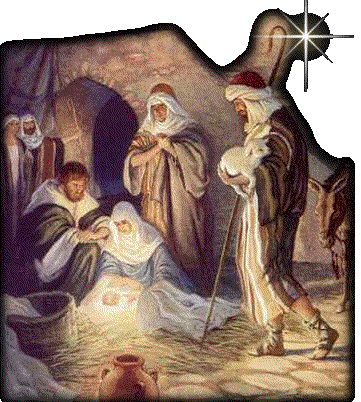 |
|
Around midnight, the stars in the heavens lit up the stable as Mary gave birth to a male child. Filling the manger with straw, she wrapped him in swaddling clothes and laid him in his make-shift bed. The little town of Bethlehem slept peacefully, unaware of the blessed event that had taken place.
|
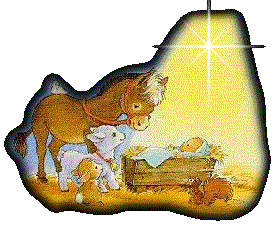
|
When the Lord Jesus Christ was born, there appeared in the east an unusually bright star. Seeing this star were three wise men, who knew that the promised child of God had been born, the Messiah. Anxious to see the Messiah, they set out to find him, as the brilliant star shining from the heavens above guided their way. When they reached Bethlehem, they came to the stable where Jesus lay in the manger. When the wise men entered, and saw the child with his mother, they fell on their knees. Gifts of gold, frankincense and myrrh were laid at the feet of the Christ-child. And the angels sang.
|
| The first to hear of the birth of Christ were the shepherds of Bethlehem who were watching their sheep. An angel from heaven brought them the joyous tidings and told them to go to the town of Bethlehem where they would find the babe in a straw-filled manger. The heavens shone with a heavenly light and angles began to sing: "Glory to God in the Highest, and on earth , Peace and Good will toward Men." The shepherds hastened to the stable where they truly found Lord Jesus Christ as a babe in swaddling clothes laying in a manger of straw. They spoke to Joseph and Mary of what they had seen and heard from the angels of heaven, and worshiped the new-born child as the Savior. The shepherds left, overjoyed, glorifying and praising God. |

The Origin of the Christmas Tree
A beautifully decorated evergreen tree, with colored lights ablaze inspires in many warm memories of Christmasses long past. The Christmas tree has become one of the most beloved and well know holiday symbols.
Thousands of years ago, some people believed that evergreen trees were magical, for even during the harsh winter months when all other trees were brown and bare, the evergreen remained strong and green. The evergreen was seen as a symbol of life, a sure sign that sunshine and spring would return soon. |
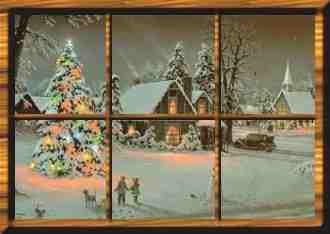
|
The tradition of a holiday tree has been around since ancient times and has played an important part in winter celebrations for many centuries. The evergreen was often decorated during the winter months. Many pagan festivals used trees when honoring their gods and spirits. The Druids of ancient England and France decorated oak trees with fruit and candles to honor their gods of harvests. Candles were often used, an ancient symbol of the Vikings representing the light of spring triumphing over the darkness of winter. The electric lights we use today are symbolic of that ancient practice.
In ancient Rome, at the festival Saturnalia held in December; people decorated trees with trinkets and candles, and decorated their homes and their temples with greenery at this time. It was a happy time, a time of peace. No battles could be fought and people everywhere joined in the carnival-like atmosphere and gave each other presents.
There have also been many legends surrounding the lore of the Christmas tree. One legend has it that on the night of the Saviour's birth, all the living creatures, both flora and fauna, came to Bethlehem with gifts. The olive tree brought its fruit and the palm its dates. But the little fir tree had no gift and was so tired it couldn't resist when the big trees pushed it into the background and hid it from view. But then a nearby angel took pity and commanded a cluster of stars to come and rest on its delicate boughs. When the Baby Jesus beheld this lovely lighted tree, He smiled and blessed it, declaring henceforth that fir trees should always be filled with lights at Christmastime to please little children.
Another legend has it that the tradition of having indoor trees was begun in Germany by Martin Luther; a monk and church reformer (1483 to 1546). According to the legend, Luther was returning home one winter's night when he saw the stars twinkling in the sky through the branches of the trees. So amazed by the sight, he was eager to tell his family about it. Luther was so inspired by the beauty of the sight that he cut down a small evergreen and brought it home. He recreated the stars by putting candles on the tree's branches.
In the earliest legend, Saint Boniface, an English monk and missionary, came upon a group of Germanic Druids outside the town of Geismar, who had gathered around an oak tree and were preparing to sacrifice a child. To convince the idolaters that the oak tree was not sacred and inviolable, so as to stop the sacrifice and save the child, the "Apostle of Germany" flattened the oak tree with one blow of his fist. Toppling, it crushed every shrub in its path except for a small fir sapling, which appeared to spring up in its place. Boniface, attempting to win converts, interpreted the fir's survival as a miracle, concluding, "Let this be called the tree of the Christ Child." Subsequent Christmasses in Germany were celebrated by planting fir saplings.
The history of the modern Christmas tree dates back to 16th century Germany. In Alsace (Elsass), dated 1561, states that "no burgher shall have for Christmas more than one bush of more than eight shoes' length." The decorations hung on a tree in that time, the earliest we have evidence of, were "roses cut of many-colored paper, apples, wafers, gilt, sugar." Around Strasbourg there was a widespread practice of bringing evergreen trees into houses for decoration during Christmastide. Also related to the modern Christmas tree, is that of the Paradise tree which was strung with apples, and found in the medieval religious plays. The decorations could symbolize the Christian Hosts. In some areas evergreen trees were scarce, and so various wooden pyramidal structures were also used which were then decorated with branches and candles.
In 17th century the Christmas tree spread through Germany and Scandinavia. Eventually the tree was extensively decorated, first with candles and candies, then with apples and confections, later with anything glittering mass-produced paraphernalia.
The tradition of the Christmas tree eventually spread through out Europe. In England, the Christmas tree first appeared when Queen Victoria married Prince Albert, who was German. In 1841, Prince Albert, set up the first English Christmas Tree at Windsor Castle and decorated it with candles, candies, fruits, and gingerbread near London to remind him of his homeland. |
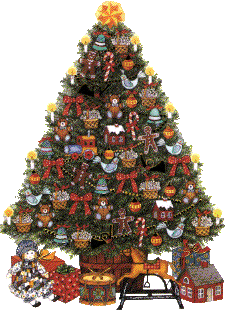
|
In the diary of Matthew Zahm of Lancaster, Pennsylvania, recorded on the date of December 20, 1821, it is noted that the Christmas tree and its myriad decorations received their first mention in the New World. The claim of the Pennsylvania Germans to have initiated the Christmas tree custom in America is undisputed to the present day. The custom of the Christmas tree was introduced to the United States by German immigrants who arrived in the 1800's. In the 1830's most Americans still considered the Christmas tree an oddity. One of the first public displays of a Christmas tree was set up by German Settlers in Pennsylvania. At the time many still considered the tree to be a symbol of pagans. To the New England Puritans, Christmas was sacred. The Pilgrims' second governor, William Bradford, wrote that he tried hard to stamp out "pagan mockery" of the observance, penalizing any frivolity. The influential Oliver Cromwell preached against "the heathen traditions" of Christmas carols, decorated trees and any joyful expression that desecrated "that sacred event." |
It wasn't until the late 1800's that Americans began accepting the Christmas tree. Early Christmas trees were often decorated with apples, nuts, cookies, colored popcorn and candles. Public outdoors Christmas trees with electric candles were introduced in Finland in 1906, and in New York City in 1912. In the present day, it is very common throughout the United States to feature public displays of Christmas trees. Each year, the President of the United States lights the National Christmas Tree in Washington, and in New York City, ice skaters spin merrily beneath the lighted tree at Rockefeller Center. |
No matter the origin, the Christmas tree is a beautiful, wonderful symbol for every one who celebrates — and even for those who do not celebrate — Christmas.

The Origin of Santa Claus
The original Santa Claus was born in the ancient southeastern Turkish town of Lycia early in the fourth century. His generosity was legendary; he was particularly fond of children. Primarily through Roman accounts we learn of his patronage of youth, which eventually led to his becoming the patron saint of children, known then as St. Nicholas. Throughout the Middle Ages, and well beyond, he was referred to by many names, though none of them were "Santa Claus."
Children in the United States today would not recognize the St. Nick who brought gifts to European children hundreds of years ago, except for perhaps his long white beard. He made his rounds in full red-and-white bishop's robes, complete with twin-peaked miter and crooked crozier. His sled was pulled by no fleet-footed reindeer, but instead rode and coaxed an indolent donkey. St. Nick arrived not late on Christmas Eve, but on his Christian feast day, December 6. The gifts he left beside the hearth were usually small, such as fruit, nuts, hard candies, wood and clay figurines.
During the Protestant of the sixteenth century, St. Nicholas was banished from most European countries. Replacing him were more secular figures, who in general were not at center stage at that point in history. The Dutch, however, kept the St. Nicholas tradition alive. In sixteenth-century Holland, children placed wooden shoes by the hearth the night of St. Nicholas's arrival. The shoes were filled with straw, a meal for the saint's gift-laden donkey. In return, Nicholas would insert a small treat into each clog. In America, the shoe was replaced with the stocking, hung by the chimney. |
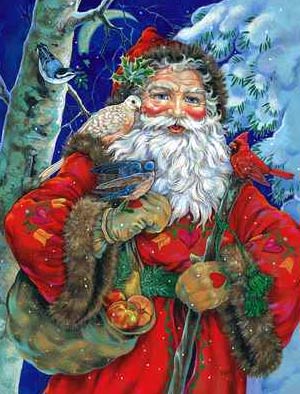
|
And, as the "protector of sailors," St. Nicholas graced the prow of the first Dutch ship that arrived in America. And the first church built in New York City was named after him. The Dutch brought with them to the New World two Christmas items that eventually became an American tradition. The Dutch spelled St. Nicholas "Sint Nikolass," which in the New World became "Sinterklass" and later changed to "Santa Claus." |
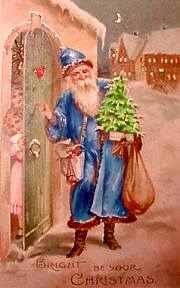
|
Santa Claus is known throughout the world in many different names; Saint Nikolaas (Sinter Klaas), from the Dutch Father Christmas, from the English Kris Kringle, Christkind from the Germans, Befana from the Italians, Bobouschka, from the Russians (a grand motherly figure instead of a male).
Much of modern-day Santa Claus lore, including the reindeer-drawn sleigh, originated in America. It was in America that Santa put on weight. The rosy-cheeked, roly-poly Santa is credited to the influential nineteenth-century cartoonist Thomas Nast. From 1863 until 1886, Nast created a series of Christmas drawings for Harper's Weekly. These drawings, executed over twenty years, exhibit a gradual evolution in Santa from the pudgy, diminutive, elf-like creature of Dr. Moore's immortal poem to the bearded, potbellied, life-size bell ringer familiar on street corners across America today. Nast's cartoons also showed the world how Santa spent his entire year constructing toys, checking on children's behavior, reading their requests for special gifts. Dr. Clement Clarke Moore composed "The Night Before Christmas" in 1822, to read to his children on Christmas Eve. The poem might have remained privately in the Moore family had a friend had not mailed a copy of it to a newspaper. |
Santa delivers presents to all good children and in accordance to tradition. The legend of the traditional hanging of the Christmas stocking began when Saint Nicholas dropped gold coins down a poor family's chimney and the coins landed in stockings hung by the fire to dry.
Each year, letters come to from all around the world, delivered to his home at the North Pole, where he lives with Mrs. Claus, as well as all of his helper elves and reindeer. Santa's helpers gather the mail to make sure everyone's letter gets to him. |
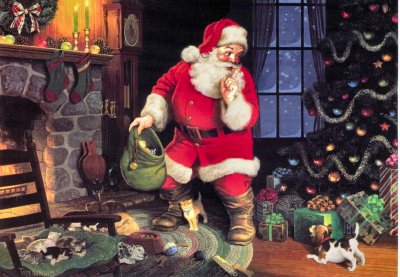
|
Before Santa begins his long journey each Christmas, he checks his list to make sure that all the children's names are on it and that all the presents are packed, as well as ensuring the reindeer are well-fed before the long trip, and the sleigh in good condition. When Santa arrives on your roof top, everyone asleep and are dreaming of all the presents and candy that they will get when they wake up in the morning, he makes sure that his list is correct and that all the presents are in his bag. As he starts down the chimney with his bag of presents on his shoulder, he slips down the chimney and makes sure that he fire is not burning as to not hurt him. As he reaches the bottom and climbs out of the fireplace, Santa makes sure that everyone is asleep and he is quite as a mouse as he put the present under the tree and fills the stacks. If your house does not have a fireplace don't worry Santa is pretty slick, he finds a way in. |
Santa is always kind to all God's creatures. In addition to bring presents to all the children in the world, Santa also observes the European Christmas Eve tradition of placing grain outside for the wild animals. All year long Santa takes care of his reindeer herd and all the animal friends around his home by playing and feeding them and being kind and a friend to them.

The Origin of the Reindeer Legend
Ordinary reindeer, as well as their flying counterparts play an important role in the Santa Claus legend. The story of the eight flying reindeer is believed to have originated by Clement Clarke Moore in his early 19th century poem "Twas the Night Before Christmas." |

|

|
For many centuries, reindeer have been domesticated in their original habitat, which ranges from Norway and into northern Asia. Because of their strength, speed, and endurance, hey have been trained to wear harnesses for pulling sleds over snow. The reindeer are sturdy, short-legged animals, with a brownish coat that is dark in the summer and light in winter; the long hairs under the neck, the fur just above the hoofs and the region about the tail are almost white. The male (or stag) measures about six feet (6') in length and is about thirty-six inches (36") tall, measured at the shoulder; the doe is somewhat smaller. The animals have large, spreading hoofs that enable them to travel on snow-covered areas. They feed on vegetation such as grasses, leaves, mosses, and lichens, obtained by scraping away the snow cover with their antlers and hoofs. |

The Origin of "The Twelve Days of Christmas"
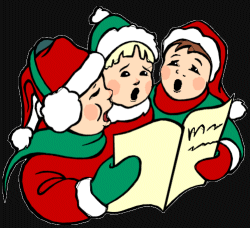
|
"On the first day of Christmas, my true long sent to me …"
I'm sure that you are all familiar with this song heard each year at Christmas. To many, I'm sure, it's simply a wonderful bit of musical whimsy. Let's have a look at a popular story that has been posted on the internet for several years, a story which is, of course, not even remotely accurate. |
You're all familiar with the Christmas song, "The Twelve Days of Christmas" I think. To most it's a delightful nonsense rhyme set to music. But it had a quite serious purpose when it was written.
It is a good deal more than just a repetitious melody with pretty phrases and a list of strange gifts.
Catholics in England during the period 1558 to 1829, when Parliament finally emancipated Catholics in England, were prohibited from ANY practice of their faith by law - private OR public. It was a crime to BE a Catholic.
"The Twelve Days of Christmas" was written in England as one of the "catechism songs" to help young Catholics learn the tenets of their faith - a memory aid, when to be caught with anything in writing indicating adherence to the Catholic faith could not only get you imprisoned, it could get you hanged, or shortened by a head - or hanged, drawn and quartered, a rather peculiar and ghastly punishment I'm not aware was ever practiced anywhere else. Hanging, drawing and quartering involved hanging a person by the neck until they had almost, but not quite, suffocated to death; then the party was taken down from the gallows, and disembowelled while still alive; and while the entrails were still lying on the street, where the executioners stomped all over them, the victim was tied to four large farm horses, and literally torn into five parts - one to each limb and the remaining torso.
The songs gifts are hidden meanings to the teachings of the faith. The "true love" mentioned in the song doesn't refer to an earthly suitor, it refers to God Himself. The "me" who receives the presents refers to every baptized person. The partridge in a pear tree is Jesus Christ, the Son of God. In the song, Christ is symbolically presented as a mother partridge which feigns injury to decoy predators from her helpless nestlings, much in memory of the expression of Christ's sadness over the fate of Jerusalem: "Jerusalem! Jerusalem! How often would I have sheltered thee under my wings, as a hen does her chicks, but thou wouldst not have it so …"
The other symbols mean the following:
2 Turtle Doves = The Old and New Testaments
3 French Hens = Faith, Hope and Charity, the Theological Virtues
4 Calling Birds = the Four Gospels and/or the Four Evangelists
5 Golden Rings = The first Five Books of the Old Testament, the "Pentateuch", which gives the history of man's fall from grace.
6 Geese A-laying = the six days of creation
7 Swans A-swimming = the seven gifts of the Holy Spirit, the seven sacraments
8 Maids A-milking = the eight beatitudes
9 Ladies Dancing = the nine Fruits of the Holy Spirit
10 Lords A-leaping = the ten commandments
11 Pipers Piping = the eleven faithful apostles
12 Drummers Drumming = the twelve points of doctrine in the Apostle's Creed
Although the task of discovering exactly when this particular song is written, and the reason why, is extremely difficult — and has still not been proven, even today! — what we do know is that the twelve days of Christmas in the song are the twelve days between the birth of Christ (Christmas, — December 25) and the coming of the Magi (Epiphany, — January 6). Although the specific origins of the song "The Twelve Days of Christmas" are not known, it possibly began as a Twelfth Night "memory-and-forfeits" game in which the leader recited a verse, each of the players repeated the verse, the leader added another verse, and so on until one of the players made a mistake, with the player who erred having to pay a penalty, such as a offering up a kiss or a sweet. This is how the song was presented in its earliest known printed version, in the 1780 children's book Mirth Without Mischief (it seems that the song is apparently much older than this 1780 printed version, however it is not known how much older.) Textual evidence indicates that the song "The Twelve Days of Christmas" was actually not English in origin, but French. Three French versions of the song are known, and items mentioned in the song itself (the partridge, for example, which was not introduced to England from France until the late 1770s) are indicative of a French origin.
It is quite possible, perhaps probably, that "The Twelve Days of Christmas" has been confused with a song called "A New Dial" (also known as "In Those Twelve Days") which dates to approximately 1625 and assigns religious meanings to each of the twelve days of Christmas, however not for the purposes of teaching a catechism. In a manner somewhat similar to the memory-and-forfeits performance of "The Twelve Days of Christmas," the song "A New Dial" was recited in a question-and-answer format.
What are they that are but one?
We have one God alone
In heaven above sits on His throne.
What are they which are by two?
Two testaments, the old and new,
We do acknowledge to be true.
What are they which are but three?
Three persons in the Trinity
Which make one God in unity.
What are they which are but four
Four sweet Evangelists there are,
Christ's birth, life, death which do declare.
What are they which are but five?
Five senses, like five kings, maintain
In every man a several reign.
What are they which are but six?
Six days to labor is not wrong,
For God himself did work so long. |
What are they which are but seven?
Seven liberal arts hath God sent down
With divine skill man's soul to crown.
What are they which are but eight?
Eight Beatitudes are there given
Use them right and go to heaven.
What are they which are but nine?
Nine Muses, like the heaven's nine spheres,
With sacred tunes entice our ears.
What are they which are but ten?
Ten statutes God to Moses gave
Which, kept or broke, do spill or save.
What are they which are but eleven?
Eleven thousand virgins did partake
And suffered death for Jesus' sake.
What are they which are but twelve?
Twelve are attending on God's son;
Twelve make our creed. The Dial's done. |

The Origin of Rudolph the Red-Nosed Reindeer
Perhaps most significantly, reports by sociologists report that "Rudolph, the Red-Nosed Reindeer" is the only new addition to the folklore of Santa Claus in the twentieth century. In 1939, Robert May, an advertising copywriter for the Montgomery Ward department store in Chicago, needed and searched for something novel for its in-store Santa Claus to distribute to parents and children. May conceived the idea of a shiny-nosed reindeer, a Santa's helper. An artist friend of May's, Denver Gillen, spent hours at a local zoo creating whimsical sketches of reindeer at rest and at play. May considered many names and finally settled on Rudolph, based on the preference of his four-year-old daughter. That Christmas of 1939, 2.4 million copies of the "Rudolph" booklet were handed out in Montgomery Ward stores across the country. |

|
"Rudolph" was reprinted as a Christmas booklet sporadically until 1947. That year, a song-writing friend of May's by the name of Johnny Marks, put the poem to music. However, one professional singer after another declined the opportunity to record the song. In 1949, Gene Autry consented. The Autry recording rocketed to the top of the Hit Parade and since then, over three hundred different recordings have been made, and more than eighty million records sold. The original Gene Autry version is second only to Bing Crosby's "White Christmas" as the best-selling record of all time. Rudolph moved on and became an annual television star and a familiar Christmas image in many of the countries whose own lore had enriched the international St. Nicholas legend.

The Origin of the Candy Cane
As with many stories of Christmas, there are stories passed around based on truths, but many on suppositions and very creative minds. One such story is that of the origins of the candy cane. It has become fashionable of late to claim that the candy cane was not only designed to be filled with Christian religious symbolism, but that it was created as a means by which persecuted Christians could secretly identify each other. Like the apocryphal tale of the "true" meaning of the song "The Twelve Days of Christmas," these claims are fiction — latter day attempts by those with extraordinarily creative minds to perhaps infuse simply and ordinary holiday traditions with specifically religious origins and meanings. Let's explore the facts with a couple of stories I've seen posted. |

|
The Stories:
"The peppermint plant is a member of the hyssop family, referred to in the Old Testament as a medicinal herb used for cleansing. The candy cane represents one of the oldest symbols of Christmas, the shepherd's crook, for the shepherds were among the first to experience that first Christmas. The colors of the candy cane have special meaning as well. The wide red stripe represents the sacrifice of Christ, "For by his stripes we are healed"; the narrow red stripes represent our own sacrifices (i.e., giving); and the white stripes are a symbol of purity."
"Candy canes were created to symbolize Jesus, their shape representing the letter "J" and their colors standing for the purity and blood of Christ. A candymaker in Indiana wanted to make a candy that would be a witness, so he made the Christmas Candy Cane. He incorporated several symbols from the birth, ministry, and death of Jesus Christ. He began with a stick of pure white, hard candy. White to symbolize the Virgin Birth and the sinless nature of Jesus, and hard to symbolize the Solid Rock, the foundation of the Church, and firmness of the promises of God. The candymaker made the candy in the form of a "J" to represent the precious name of Jesus, who came to earth as our Savior. It could also represent the staff of the "Good Shepherd" with which He reaches down into the ditches of the world to lift out the fallen lambs who, like all sheep, have gone astray. Thinking that the candy was somewhat plain, the candymaker stained it with red stripes. He used three small stripes to show the stripes of the scourging Jesus received by which we are healed. The large red stripe was for the blood shed by Christ on the cross so that we could have the promise of eternal life. Unfortunately, the candy became known as a Candy Cane — a meaningless decoration seen at Christmas time. But the meaning is still there for those who "have eyes to see and ears to hear." Every time you see a Candy Cane, remember the Wonder of Jesus and His Great Love that came down at Christmas, and that His Love remains the ultimate and dominant force in the universe today. "
Candy canes are also said to have been created:
• As a sweet treat for children who behaved well in church.
• As a form of identification among Christians during a time of persecution.
The facts:
The red-and-white-striped, sugary candy cane can be found everywhere at Christmastime, as much an ornament as it is a confection, and people enjoy eating decorating with them, without a thought as to where candy canes originate.
Quite simply, the creative idea that candy canes could have been used as a secret means of identification by persecuted European Christians is directly and absolutely contradicted by history. Candy canes didn't appear until the latter part of the 17th century, by which time Europe was almost entirely Christian, and those not of the Christian faith were more likely the persons to be persecuted!
Secondly, candy canes were not created by "a candymaker in Indiana" who "stained them with red stripes to show the stripes of the scourging Jesus received." Candy canes were around a heck of a long time before there was an Indiana! Too, the first candy canes had neither the red coloration nor the striping — the red stripes were a feature that did not appear until the beginning of the 20th century!
In approxmately 1847, August Imgard of Ohio managed to decorate his Christmas tree with candy canes to entertain his nephews and nieces. Many who saw his canes went home to boil the sugar and experiment with canes of their own. It took nearly another half century longer before someone added the stripes to the canes. Even on Christmas cards produced before 1900 embody plain white canes; striped candy canes appear on many cards printed early in the 20th century.
Soon after Europeans adopted the use of Christmas trees, they began making special decorations for them. Food items predominated, with cookies and candy heavily represented. That is when straight, white sticks of sugar candy came into use at Christmas, probably during the seventeenth century. To be sure, the foremost connection anyone can relate between the origins of the candy cane and intentional Christian symbolism is to note the legend which says that someone took an existing form of the candy cane, which was already being used as a Christmas decoration (i.e., these straight white sticks of sugar candy), and produced bent versions which represented a shepherd's crook and were handed out to children at church to ensure their good behavior. Tradition has it that some of these candies were used in the Cologne Cathedral (circa approximately 1670) while restless youngsters were attending ceremonies around the living creche. In an effort to keep them quiet, the choirmaster persuaded craftsmen to make sticks of candy bent at the end to represent shepherds' crooks, then he passed them out to boys and girls who came to the cathedral.

The Origin of the Yule Log

|
Although there are only a few Americans who practice this tradition, the burning of the yule log was at one time one of the most firmly established and practiced customs of Christmas. There was a ritual to the burning of the yule log, and certain steps had to be followed very carefully, lest disaster befall the household in the upcoming year.
Firstly, it was unlucky to buy a yule log. Lucky ones were obtained from a person's own land or from a neighbor's wood. Often the "log" was simply a stump or a root and not necessarily a full log, which was brought home on Christmas Eve and laid in the hearth. |
The first step towards lighting the yule log was fetching the carefully-preserved scrap of the previous year's log from under the homeowner's bed. Having done its job of keeping the house safe from fire and lightning since the previous Christmas season, it was now to be used to light the new log. The new log had to catch fire during the first attempt at lighting it; its failure to do so was a sign of misfortune coming to the family. Such an important duty had to be handled respectfully and seriously. For example, soiled hands would have been seen as an act of disrespect.
Once lit, the log had to be kept burning for twelve hours! Such was not always an easy task, as special caution was given against stirring the embers during the lengthy Christmas Eve supper. The log could not be tended as long as any scrap of the dinner remained on the table, or while anyone was still eating! As the log burned, people told tales of olden times as well, as ghost stories, while drinking cider. Shadows cast upon the wall were carefully examined, for it was well known that a headless shadow foretold the death of the person casting it within the year.
Similar to the yule log was the Christmas candle. It too was lit on Christmas Eve, usually just at dusk. Care was taken to keep it burning at least as long as the hosts were still up, sometimes all night, depending on regional custom. Like the yule log, a proper Christmas candle could not be bought, so grocers made a practice of handing them out to customers. A bit of the burnt-down candle was also preserved from one year to the next as a lucky charm for the household.
A more popular version of the yule log is used in today'sn society called the buche de noel. This is a sponge cake, rolled and frosted in chocolate, then decorated to look like a yule log, and is traditionally served as part of the Christmas Eve meal in France called reveillon, which takes place after midnight Mass.
The HTML, FLASH, JAVA, graphics and original descriptions contained on these pages are not public domain and are not available for download or use. Unless otherwise specified these are all the exclusive property of Copyright ©1994-2016 MOON Productions® The Rattt Trap, Cybele Designs and Designs by Char are owned by MOON Productions. All rights reserved. Best viewed at 1024 x 768 with IE 5.5 or higher.
|